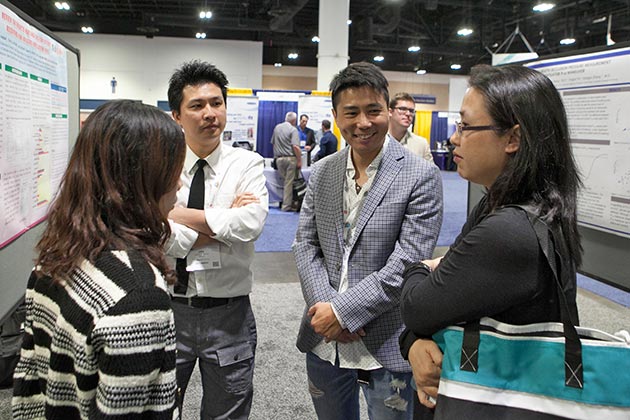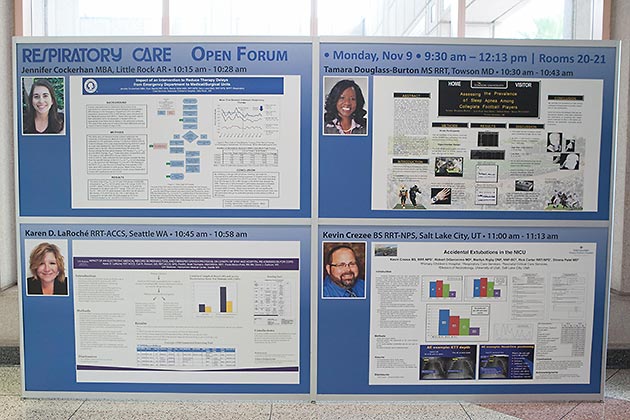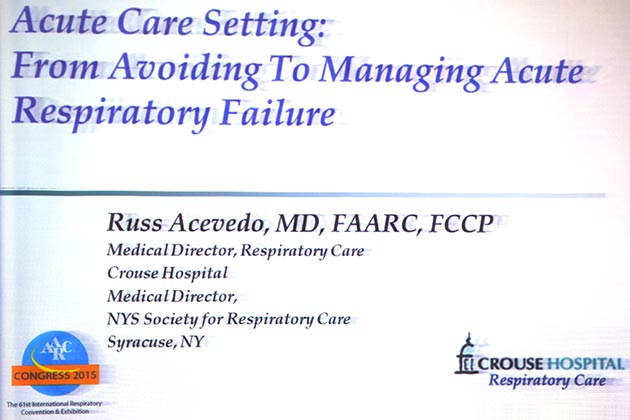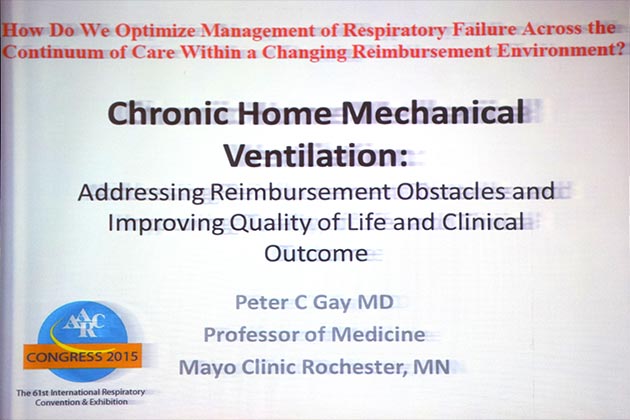Reaching across borders

Speakers, exhibitors, and attendees from abroad have gathered with their U.S. colleagues this week in Tampa, and the result has been an unprecedented sharing of information across borders that can only bode well for the future of respiratory care and the patients it serves.
The 2015 Open Forum is a great example of the broad horizons now enjoyed by the profession. These international colleagues presented their work —
- Ivan Lee BSRT, Singapore
- Hao-Yan Wang, Beijing China
- Andrew West MAPPSC RRT FCSRT, Winnipeg MB Canada
- Eun Young Kim, Seoul Korea
- Chin-Jung Liu MSc, Taichung Taiwan
- Muhammad Abdullah CPFT, Lahore Pakistan
- Takamitsu Kubo, Sunto-Gun Nagaizumi-Cho, Japan
- Nishigami Masami, Kishiwada Japan
- Leonardo De Souza PhD, São Gonçalo Brazil
- Shu Wah Ng, Hong Kong
- Pui Fan Chan MSN, Hong Kong
- Qi Guo MD PhD, Shenzhen Guangdong China
- Riccardo Guarise, Milan Italy
- Udupi Karnataka, India
- Hana Alsomali, Khoba Saudi Arabia
- Ya Wang, Hsinchu Taiwan
- Adil Alotaibi, Nottingham United Kingdom
- Fatimah Al Alshaikh PhD, Southampton Hants United Kingdom
- Adil Alotaibi, Riyadh Saudi Arabia
- Yi-Hao Peng, Taichung Taiwan
- Sunitha Palanidurai BSRT RRT-ACCS, Singapore
- Chia-Chen Chu MSc, Taichun, Taiwan
- Hsiumei Lee, Kaohsiung Taiwan
- Man Chi Lu, Kaohsiung Taiwan
- Malte Hanelt, Tuebingen Germany
- Masahiko Kimura, Sagamihara-Si Japan
- Abdulaziz Alshammary, Dhahran Saudi Arabia
- Jui Liu, Kaohsiung City Taiwan
- Lien Shi Sheng, Kaohsiung Taiwan
- Edward Banguera, Cali Valle Colombia
- Angela Arevalo CRT, Cali Valle Colombia
- Diana Serrato MSc RRT, Cali Valle Colombia
- Jiahui Ma, Changchun China
- Stefan Ponto ING MBA, Würzburg Germany
- Taha Ismaeil, Beeston Nottingham United Kingdom
- Yusuke Chikata PhD, Tokushima Japan
Our International Fellows have added another component to the mix, as they sit in on sessions to learn the latest from clinicians here in this country and share their own practices with U.S. colleagues in informal networking sessions. We are pleased to welcome them to the meeting — Peifeng Xu, China; Musa Muhtaroglu, Cyprus; Ramesh Unnikrishnan MSc RRT, India; Hussain Jassim Khatam MHS RRT FAARC, Bahrain.
We’d also like to recognize the sponsors of our International Fellowship Program: the AARC, the AARC House of Delegates, Draeger Medical, Inc., Medtronic, Philips Respironics, Teleflex.
Donald F. Egan Scientific Memorial Lecture — Navigating the Monitoring Minefield
 Charles G. Durbin, Jr., MD, FAARC, delivers the Donald F. Egan Scientific Memorial Lecture
Charles G. Durbin, Jr., MD, FAARC, delivers the Donald F. Egan Scientific Memorial Lecture
It’s great to have so many monitors out there today to tell us when our patients may be in distress. But the alarm fatigue created by this plethora of devices has led some to wonder if they may be doing more harm than good.
Charles G. Durbin, Jr., MD, FAARC, reviewed the good, the bad, and the ugly in the monitoring arena in this morning’s Donald F. Egan Scientific Memorial Lecture.
He began by using his own long history in the field of anesthesia to illustrate how monitoring has developed over the years, noting when he first got into the field anesthesiologists were using the “finger on the pulse” method to ensure their patients in the operating room were still alive.
The problem with that method was, the finger was placed on the pulse only about 5% of the time.
As a young physician he helped to promote the use of continuous monitoring with a precordial stethoscope in the operating room after taking care of a patient whose heart stopped during surgery. He was alerted to that fact by the stethoscope and told the surgeon. The patient was promptly revived and survived, and his hospital adopted the use of the monitoring device.
Much of his talk, however, focused on the use of pulse oximetry as a continuous monitoring device for surgical and other patients and the research that has been conducted in the area.
According to the professor of anesthesiology and surgery at the University of Virginia Health System in Charlottesville, many papers have compared the accuracy of different pulse oximeters and then classified them on this basis. But few have actually addressed the positive or negative impact a pulse oximeter may have on patient care, and the majority of those that did only identified near misses in diagnosing and preventing hypoxic injuries and did not include a control group cared for without the use of a pulse oximeter for comparison purposes.
The one controlled quality evaluation of pulse oximetry that did compare outcomes on anesthesia and surgery patients cared for with and without the use of the device found no benefit in clinical outcomes. In fact, patients in the monitored group were actually more likely to be diagnosed with hypoxemia, received more supplemental oxygen, spent more time in the recovery room, and suffered more pulmonary dysfunction, possibly as a result of the greater use of oxygen therapy.
“They actually found good reasons not to use pulse oximeters,” said Dr. Durbin. But that wasn’t enough for physicians surveyed about the use of the device to consider giving it up, with about 90% reporting one or more reason to continue using it.
Dr. Durbin emphasized that it is not the information gleaned from the monitor that makes a difference, but how the clinician acts on that information. He believes this paradigm should be used to test the value of the care plan that is initiated and supported by the presence of any monitor and went on to cite a study he conducted after the introduction of a read through motion pulse oximeter was introduced to the market.
In his study, patients were monitored with both the new pulse oximeter and a standard pulse oximeter applied to fingers on each of their hands. Caregivers were assigned to be shown the results from only one of the devices. Results showed clinicians managing patients with the newer pulse oximeter weaned patients faster to an FIO2 of 0.40, obtained fewer arterial blood gas measurements, and made the same number of ventilator changes during the weaning process.
“When caregivers are given a better monitor they will deliver better care,” said Dr. Durbin.
Another study out of Canada that was published in 2014, however, shows how clinicians may over-depend on these devices. In this study, otherwise healthy infants with mild to moderate bronchiolitis and true oxygen saturations of 88% or higher were assigned to either a pulse oximeter that gave the true results or one that gave readings that were 3% higher. The researchers found infants with the altered readings were less likely to be hospitalized within 72 hours or to receive active hospital care for more than six hours than those with unaltered oximetry readings.
“Everything favored the inaccurate monitor,” said Dr. Durbin. “They were changing the monitor into a diagnostic tool.”
Today the Patient Safety Foundation is advocating the use of continuous pulse oximetry on many more patients, and while the physician applauds efforts to improve patient safety, he strongly believes monitoring alone won’t solve the problem. “You can’t not see the human part of this,” he emphasized. “A continuous monitor and a person watching it is my take home message.”
To drive home his point, Dr. Durbin offered a quote attributed to Dr. Donald F. Egan which said, “The best monitor for quality and safe patient care are the senses and observations of a knowledgeable and alert health care provider.”
“Monitoring at a distance only gets the process started,” said the physician. “You need a knowledgeable health care provider — and that’s all of you out there.”
Growing Opportunities for RTs in Post-Acute Care

Despite the rise in chronic disease in the U.S. and around the world, the health care system is still structured and financed to manage acute care episodes. Patients are supposed to seek out care and then be cured and go on their merry way.
Zach Gantt, RRT, explained how that is changing in a talk earlier today that touched on everything from the post-acute care landscape to increasing opportunities for RTs in skilled nursing facilities (SNFs).
“Two-thirds to three-fourths of costs are in chronic conditions,” noted the CEO of Encore Healthcare, LLC and CCO of Evermind, Inc. Alternative payment methods favor a greater emphasis on managing chronic diseases, and 35% of Medicare beneficiaries who are discharged from an acute care hospital receive post-acute care either in a long term acute care hospital (LTACH), inpatient rehabilitation unit, skilled nursing facility (SNF), outpatient rehabilitation center, or in their own homes.
These factors are driving the post-acute care market. “The system is moving toward outcome based payment,” said Gantt. The challenge for respiratory therapists is “to figure out how to create our own spot.”
He believes opportunities are already out there. New reimbursement rules governing LTACH thresholds, for example, are going to make it less attractive for them to care for less acute patients and SNFs are increasingly moving to more of a subacute level of care — including the addition of ventilator units in some. These facilities are hiring RTs to accommodate the shift.
Studies are bearing out the value RTs can play in these facilities. The national average for congestive heart failure (CHF) patients in one study, for example, was 24.8% vs. 1% for facilities where patients were treated by RTs. The figures were 18.3% vs. 1.5% for patients with pneumonia.
Another study involving patients who were cared for by RTs across the continuum (hospital to SNF to home) found readmissions for COPD patients dropped from 24% before implementation of the program to 4%. For CHF patients readmissions went from 24% to 0%.
A health system in California saw respiratory readmissions at two facilities plummet from about 23% and 30%, respectively, to 0% and about 5%, respectively, after they hired two full time RTs to provide basic respiratory services. “Putting a respiratory therapist in there just 40 hours a week made this difference,” noted Gantt.
He is seeing positive outcomes for a post-acute care RT navigator model he has set up through an Accountable Care Organization as well. In that model, the RT goes into the hospital and all of its post-acute care settings to ensure the team has all the data it needs to effectively care for the patient.
Gantt believes advanced technologies that allow for more intensive care outside of the acute care hospital, coupled with telemedicine and other Internet based methods of monitoring patients and ensuring compliance, will further increase opportunities for RTs in post-acute care settings.
For example, remote monitoring devices that allow clinicians to know when a patient takes an extra treatment or reduces his activity level can trigger the need for an intervention. The use of more sophisticated devices such as noninvasive open lung ventilation can increase rehab minutes in the SNF, effectively qualifying the patient for a higher payment level.
“The technology is there,” said Gantt. “It’s at our fingertips. We just need to figure out how to use it.”
Editor’s Choice presentations

The Open Forum has been a great source of original research in the respiratory care profession all week, and will continue today with sessions scheduled till the late afternoon.
This morning, however, attendees had the chance to learn more about the top 11 abstracts during the Editor’s Choice presentations. Here’s what made the cut —
- High Priority Ventilator Alarms That Received No Intervention: An Analysis of Ventilator Alarm Informativeness in Intensive Care Units—Jefferson H Mixell BS RRT, Newark DE
- Does the Selection of Endotracheal Securing Devices Impact the Number of Unplanned Extubations in a Neonatal Population?—Lindsey Borock AAS, Ann Arbor MI
- Screening of Exercised-Induced Bronchoconstriction in College Student-Athletes—Dave Burnett PhD RRT AE-C, Kansas City KS
- Impact of an Intervention to Reduce Therapy Delays from Emergency Department to Medical Surgical Units—Jennifer Cockerham MBA, Little Rock AR
- Assessing the Prevalence of Sleep Apnea Among Collegiate Football Players—Tamara Douglass-Burton MS RRT, Towson MD
- Impact of Electronic Medical Record Screening Tool and Therapist-Driven Protocol on Length of Stay and Hospital Readmission for COPD—Karen D LaRoché RRT, Seattle WA
- Accidental Extubation in the NICU—Kevin Crezee, RRT-NPS, Salt Lake City UT
- Respiratory Procedures Done Prior to Onset of Ventilator Associated Events—Carl F Haas MLS RRT-ACCS CPFT FAARC, Ann Arbor MI
- Utilization of an Interface and Skin Assessment Tool by the Respiratory Care Practitioner to Reduce and Prevent Hospital-Acquired Pressure Ulcers Associated with Noninvasive Ventilation—Linda McKnight RRT, Little Rock AR
- Characterization of Ribavirin with Small Particle Aerosol Generator and Micropump Aerosol Technologies—Brian K Walsh MBA RRT-NPS RPFT FAARC, Boston MA
- Evaluation of Positive Pressure Delivered From a Non-Prescription Nasal Patch (Theravent™)—Nancy Johnson RRT-NPS, Cleveland OH
The Open Forum is supported by an unrestricted educational grant from Monaghan.
Your Job is About to Change

What if you were asked to add these things to your job description: a full disease management assessment, anxiety and depression screens, nutritional and functionality screens, quality of life assessments, discharge planning and education, home visits … and more?
“You will have felt like you’ve gone through Respiratory Armageddon, right?” said Russell Acevedo, MD, FAARC, FCCP, in a talk earlier this afternoon.
The respiratory care medical director at Crouse Hospital in Syracuse, NY, believes that day is coming — and RTs should embrace it. In a talk that covered everything from trends in Medicare financing to results from a program at his own facility, he made the case to his audience.
He began by noting that America is quickly building a more integrated health care delivery system and Medicare payments are increasingly being linked to quality and alternative payment models. “It’s not that far away,” warned the physician. In 2016 — which he pointed out is less than 60 days away now — alternate payment models will stand at 30%, and 85% of fee for service payments will be linked to quality.
Fast forward to 2018 and those numbers will be 50% and 90%.
Value based care is going to shift the risk from consumers, employers, health plans, and government payers to providers as well, and that is driving providers to establish programs designed to keep patients healthier and out of the acute care setting. “They are going to be looking at how well you’re managing their population,” said Dr. Acevedo.
Nowhere is that more true than among the COPD population. COPD is now included in the Medicare readmissions reduction program, and the maximum penalty percentage is being increased to 3% in FY 2015. That represents “big bucks,” he said.
Dr. Acevedo went on to cite a number of studies that support the disease management concept for patients with COPD, including a meta-analysis of 1066 patients in the Proceedings of the American Thoracic Society that showed a two-thirds reduction in hospital admissions and improved health status for patients who received self-management education.
Another meta-analysis published by the Cochrane Database of Systemic Reviews found similar results after analyzing 24 randomized controlled trials involving 8098 patients. A study that specifically gauged the value of the respiratory therapist case manager was equally positive.
In that trial, published in the American Journal of Respiratory and Critical Care Medicine, patients who received care from an RT case manager had significantly fewer hospitalizations and ED visits for COPD when compared to usual care. Importantly, all cause readmissions dropped as well, as did those for non-COPD cardiac or other pulmonary patients. Emergency department visits were down too.
A study published in Respiratory Care found a dedicated RT discharge coordinator who basically served as a single contact for caregivers and outside agencies resulted in a decrease in length of stay. While conducted in pediatric patients, the trial added clear evidence of the role the RT can play in disease management. Another study in the same publication found protocol-driven care delivered by an RT led to fewer 30 day readmissions for COPD patients than non-protocol driven care delivered by physicians.
An Australian trial found equally good results for ED visits, admissions, and length of stay for COPD and CHF patients assigned respiratory trained care facilitators.
These concepts and others helped to pave the way for the Lung Partners Program at Crouse, which places an RT in a primary care role. Each COPD patient in the program is assigned a primary RT for the present care episode and all readmissions who is responsible for certain disease management elements.
In other words, RTs are charged with a full disease management assessment, anxiety and depression screens, nutritional and functionality screens, quality of life assessments, discharge planning and education, home visits, and more. These therapists carry a patient load rather than a treatment load and they are responsible for meeting the specific needs of their patients.
The program, which went online in November of last year, has already resulted in fewer treatment errors, fewer late treatments, and fewer 30 day readmissions. “The better the patient and respiratory therapist work together, the less fractionation of care you’ll have,” said Dr. Acevedo.
He anticipants having more formal data to present at next year’s Open Forum and is looking forward to sharing it then.
“Right now is the time for the profession,” concluded Dr. Acevedo. “Respiratory therapists are the best people to take care of this population, but if we don’t do it, someone else will step in.”
When Clinical Outcomes and Reimbursement Clash

Patients who require assisted ventilation would prefer to receive it in their own homes whenever possible.
Recent changes in the durable medical equipment (DME) benefits for the devices that provide assisted ventilation at home, however, may mean an end to these services. Peter Gay, MD, professor of medicine at the Mayo Clinic in Rochester, MN, delved into the specifics this afternoon.
Understanding home mechanical ventilation, he told his audience, begins with understanding the different ventilator management needs of distinct clinical populations. What may work for a patient with a neuromuscular disease may not be right for a patient with COPD, obstructive sleep apnea, central sleep apnea, obesity hypoventilation syndrome, or another condition.
Dr. Gay noted that the need to order a backup rate governs the primary decision on the respiratory assist device (RAD). For example, the sentinel trial involving severe COPD patients found a one year mortality rate of 12% among patients who received noninvasive positive pressure ventilation (NPPV) with a backup rate vs. 33% in the control group. “It was huge, as Donald Trump would say,” quipped Dr. Gay.
Another study conducted among obesity hypoventilation syndrome patients found changing the backup respiratory rate (BURR) from an S/T mode with a high or low BURR to an S mode was associated with an increase in respiratory events of mainly central and mixed origin.
Both studies were conducted in Europe, where reimbursement for backup rates is no problem.
Dr. Gay went on to look at the common and unique features of some of the newer home mechanical ventilation devices, including average volume assured pressure support (AVAPS) and intelligent volume assured pressure support (iVAPS), and how they may impact patient care.
He cited several additional studies as well showing mixed results for the devices and modes in question.
Dr. Acevedo then offered a little background on how home mechanical ventilation first gained reimbursement in the home, noting it arose out of the desire of providers to send children who required mechanical ventilation home.
According to the physician, children were brought to the floors of Congress and ventilated there. It was hard to deny children the chance to live in their own homes, so the reimbursement was eventually approved.
The basic RAD rules that went into effect in 1999 resulted from a National Association of Medical Directors of Respiratory Care (NAMDRC) conclusion that in patients with neuromuscular disease, COPD, and other hypoventilation syndromes, use of a BPAP backup rate was clinically and financially more similar to that of a home mechanical ventilator (HMV). That led the FDA to recognize these devices as ventilators, and thus placed them in the higher paid “frequent and substantial servicing” payment classification by Medicare.
Today many newer HMVs can deliver therapy via RAD-type BPAP settings and, according to Dr. Gay, it is more difficult to tie device reimbursement to medically necessary treatment plans chosen for one patient or another when BPAP settings are deliverable with either a RAD or an HMV.
But skyrocketing charges for noninvasive pressure support ventilators are the real problem, continued the physician, and that is what led CMS to change the reimbursement rules covering these devices.
Basically, CMS has now stated that the “frequent and substantial servicing category” pertains only to ventilators used in patients who would die if ventilation was interrupted. Thus, claims for ventilators used for the treatment of conditions described in the RAD LCD will be denied as not reasonable and necessary.
He shared a denial received by one HME for a ventilator used at night for one patient. The denial read in part, “The medical records do not indicate that the beneficiary would be in danger of succumbing to death without a ventilator … no payment can be allowed for the E0464 device billed.”
The provider added a note of his own: “In addition to this they have stated that we are responsible for the bill and must pay back all reimbursement paid.”
Despite the scientific evidence supporting the use of RADs in patients with COPD, neuromuscular diseases, and other conditions, or the significantly higher costs associated with HMV, Dr. Gay believes the new DME determination essentially terminates noninvasive HMV use for all patients without the documentation of life-threatening risk.
The good news is, NAMDRC and other groups are working to mitigate this ruling, and he is hopeful that a solution will come to the fore soon.
